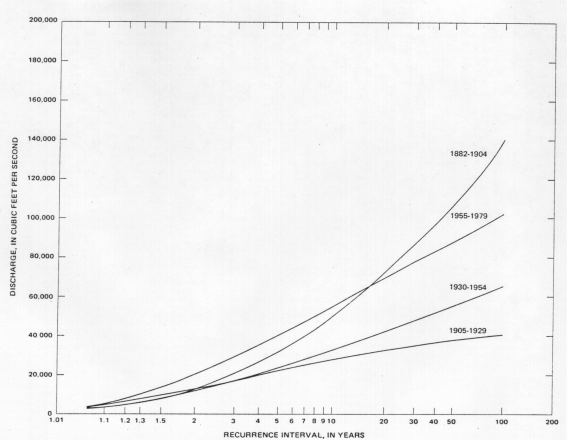
 Number 11, August 1998
Number 11, August 1998"What's happening on the Societal Aspects of Weather WWW Site."

 Number 11, August 1998
Number 11, August 1998
"What's happening on the Societal Aspects of Weather WWW
Site."
Contents:
|
An old adage says that climate is what you expect and weather is what you get. Residents of Grand Forks, North Dakota and East Grand Forks, Minnesota are now in the process of preparing for the future floods that they are inevitably going to get. An important part of their flood protection plan is an assessment of what sorts of flooding they might expect over the next few decades. A problem exists in that these two communities are almost certainly going to be surprised when what they get in the future is not what they expect today. This surprise is a function not so much of the climate, but how we think about climate.
Scientists know that weather and climate vary on all time scales, day and night, season to season, year to year, decade to decade, and at all time scales in between. Indeed, the nature and extent of these variations is one of the factors underlying debate over human-caused global warming. But global warming or not, the fact that the climate does change is well accepted. Indeed, the phrase "climate change" is redundant.
Not too long ago, scientists believed that climate was more or less stationary over time scales that matter most to people. For instance, a prominent scientist wrote in the 1940s that "while the individual day-by-day weather conditions are proverbially fickle, the climate remains fairly constant, at least within a human lifetime." The implications of this belief in climate stationarity are important for decision making: "There is no scientific reason to believe that our climate will change radically in the next few decades; hence we can safely accept the past performance as an adequate guide to the future."
Decision makers looking at flood protection strategies in Grand Forks are relying on a stationary view of climate rather than one based on variability. This is not a unique situation to Grand Forks. Indeed, much of the U.S. response to floods is based on the notion of the 100-year (or N-year) flood, itself based on the notion of climate stationarity.
Consider the 100-year flood at Grand Forks. Typically the 100-year flood is computed based on an entire flood record for one point along a river. For the 100-year record at East Grand Forks, this translates to a discharge (volume) of about 100,000 cubic feet per second (cfs). It is this information that is used by flood decision makers to evaluate "what to expect" in terms of future climate for the next 25 years or so.
But if one looks at the flood record at East Grand Forks more closely, one gets a much more complicated picture of what to expect. If we calculate the "100-year flood" at this location based on four different 24-year periods from 1882-1979, a very different picture emerges. From 1955 to 1979, the 100-year flood was slightly larger than that for the entire 98-year record, slightly more than 100,000 cfs or about equal to the 1979 flood. From 1905-1919 and 1930-1954, the "100-year flood" was significantly lower, about 40,000 cfs and 65,000 cfs respectively (or the 1975 and 1966 events, which were not really even damaging floods). From 1882-1904, the "100-year flood" was about 140,000 cfs, close to the volume seen in the devastating event of 1997! The attached figure shows the different flood frequency curves for the four periods. (Source: USGS).

What this all means is that the "100-year flood" means different things during different climate "regimes" and that the Red River basin has seen increasing flood volumes this century, although not as great as that experienced at the end of the 1800s. For decision makers in Grand Forks this means that if the next 25 years is like the end of the 1800s, a flood protection strategy based on the entire record will underestimate the true nature of the flood risk. (And vice versa if the next few decades are more like the first 50 years of this century). Only if the next 25 years are like the period 1955-1979 will a flood protection strategy based on the entire record accurately reflect the flood risk. Given that most of the historical record was not representative of the long term mean, odds are that decision makers will be surprised when the weather they get is not what they expect.
Further info:
http://www.grandforks.com/protect.htm
http://www.ijc.org
— Roger A. Pielke, Jr.
[ Contents ]
You probably don't need a reminder that it is hurricane season, with trouble brewing in the Atlantic. We thought that we'd use this opportunity to emphasize some of the best resources out on the WWW for getting information on hurricanes.
Without a doubt, the best resource for general questions on hurricanes is the Frequently Asked Questions page put together and maintained by Chris Landsea of NOAA's Hurricane Research Division. It is at: http://www.aoml.noaa.gov/hrd/tcfaq/tcfaqHED.html
Are you interested in the latest forecast information but having trouble accessing the very busy WWW site of the National Hurricane Center? Try the WeatherNet Tropical Page [http://cirrus.sprl.umich.edu/wxnet/tropical.html].
WeatherNet is a non-profit service sponsored by The Weather Underground at
the University of Michigan at Ann Arbor.
http://cirrus.sprl.umich.edu/wxnet/
Here's hoping for a safe season!!
[ Contents ]
[ Contents ]
[ Contents ]
[ Contents ]
[ Contents ]
[ Contents ]